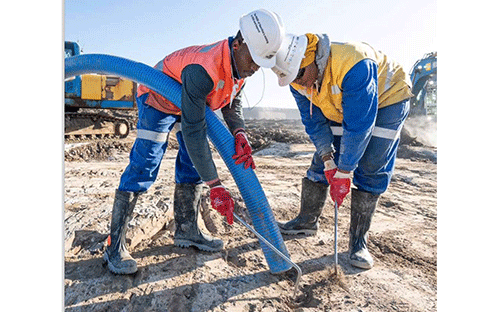The mining industry employed some 18 000 people last year, including contractors.
In terms of permanent employees, about 8 900 people were recruited, 97% of whom are Namibians.
This was revealed by Chamber of Mines CEO Veston Malango.
He said these numbers were mostly attainable from Chamber members, which include mining giants such as Namdeb, Debmarine, Rossing Uranium, Dundee Precious Metals, B2Gold and 121 other stakeholders.
“Less than 2.5% over the years are foreign nationals on work permits and visas. Now, what does that tell you? It says an industry that is capital-intensive as mining is operated by its people,” he said at the signing of the Mine Health and Safety Standard Operating Procedures in the capital recently.
The executive director (ED) of the health ministry, Ben Nangombe, along with the EDs of the ministries of labour Lydia Indombo and mines Penda Ithindi, signed the Mine Health and Safety (MHS) Standard Operating Procedures (SOPs), which focus on tackling diseases in the mining sector, especially tuberculosis (TB).
“Having many Namibians employed in the mining sector is something to be proud of – and that speaks to skills’ development and many other things,” he stated.
He noted that as capital-intensive as it is, “if you go to Husab mine, which is the largest open-pit uranium mine in the world, you will find monster equipment. That’s why the investment that went to that is huge –that piece of equipment. It is not in the interest of the CEO or MD of the mine to have a worker who is poorly-paid to operate N$150 million equipment,” he referenced.
He added that it is also not in the best interest of mining companies to have an operator working with those machines in poor health, or at risk of being exposed to other occupational lung diseases.
“It is not in our interest because the industry is capital-intensive. The most important thing is human capital, so we have to look after human capital,” he said.
He stressed that the mining industry can never put profits ahead of the well-being of humans.
Indombo stated that mining is one of the high-risk sectors, and TB in this sector is driven by many factors, including high long-term exposure to silica dust.
“Through the SOPs, we are ensuring that comprehensive frameworks for risk management, information dissemination, quality control as well as monitoring and evaluation are in place. These SOPs will guide employers, employees and all stakeholders in minimising occupational hazards, improving surveillance of health risks, as well as fostering a culture of prevention and accountability,” she stated.
She said TB and HIV are included as occupational diseases, affirming the country’s commitment to a compressive coverage of diseases contracted at or in connection with work.
-psiririka@nepc.com.na


